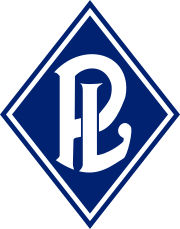Labour Party Partido Laborista | |
|---|---|
 | |
| Founder | Juan Perón |
| Founded | October 24, 1945 (first) 1957 (second) |
| Dissolved | July 1947 (first) 1965 (second) |
| Merged into | Peronist Party |
| Headquarters | Buenos Aires |
| Newspaper | El Laborista |
| Ideology | Peronism[1] Socialism[2] Syndicalism[2] Left-wing populism[3] Left-wing nationalism[4] |
| Political position | Left-wing[5][6] |
| Colours | Blue and white |
The Labour Party (Spanish: Partido Laborista) is a left-wing and populist political party in Argentina. It was created in 1945 by prominent leaders of the trade union movement in Argentina shortly before the 1946 Argentine general election and mobilized working-class support for emerging populist leader Juan Perón.[7] The party run Perón’s presidential ticket for the election.[8] It was inspired and based on the British Labour Party and is considered to have been the first instance of direct electoral mobilization of the working class in Argentina. Its goal was to bring Perón to power and institutionalize the political power of Argentinian trade union movement. After winning the 1946 presidential election, Perón merged the party into his Peronist Party.[9]
The party was part of a larger front of pro-Peronist coalition in the 1946 election, and fielded Perón on its electoral lists together with the conservative Independent Party and the Radical Civic Union Renewal Board, a left-wing splinter of the liberal Radical Civic Union. The Labour Party was the strongest pro-Peronist party in the coalition, and was considered the backbone of Perón’s electoral success in the 1946 election.[10] It had a staunchly left-wing and socialist platform which called for far-ranging redistributive measures, introduction of a social security system and pension funds for rural and industrial workers; the platform was fully embraced by Perón who managed to implement a large majority of the proposed measures under his rule.[7] The party was composed of trade unionists of socialist, anarcho-syndicalist, and communist backgrounds, and became the left wing of the Peronist movement once it was merged into Perón's personal party.[11]
- ^ de Laforcade, Geoffroy; Shaffer, Kirwin (2015). In Defiance of Boundaries: Anarchism in Latin American History. University Press of Florida. p. 196. ISBN 978-0-8130-6110-8.
From 1937 and until the creation of the pro-Peronist Partido Laborista in 1945, shipyard workers' unions were, along with the FOM, the backbone of a revived USA, and they cooperated locally with the longshoremen's resistance society and its autonomous allies federated in what remained of the anarchist FORAV.
- ^ a b Bossert, Carl Friedrich (2021). Power, Alliances, and Redistribution: The Politics of Social Protection for Low-Income Earners in Argentina, 1943–2015. Budrich Academic Press. p. 117. doi:10.3224/96665028. ISBN 978-3-96665-998-7.
Most of the Partido Laborista leaders had socialist and anarcho-syndicalist backgrounds, and the party's rank and file was influenced by the membership of defecting socialists, communists, Trotskyists and progressive UCR members (Del Campo 2012, 330–332; Murmis and Portantiero 2004, 160). These ideological influences found their expression in the progressive character of the Partido Laborista's declaration of principles and its electoral platform for 1946 (Partido Laborista 1945, 1946).
- ^ Rak, Joanna; Osiewicz, Przemysław (2008). "The Populist Response to the COVID-19 Pandemic: A Comparative Analysis of the Positions of Duda and Fernández". Serbian Political Thought. 74 (4): 6. doi:10.22182/spm.7442021.1.
In Argentina, since the founding of the left-populist Worker's Party (Partido Laborista) by Juan Perón in 1946, its representatives have served as presidents for more than half of the post-war period and achieved results in the range of 30-60% of the vote in the presidential elections.
- ^ Munck, Ronaldo; Falcón, Ricardo [in Spanish]; Galitelli, Bernardo (1987). Argentina: From Anarchism to Peronism: Workers, Unions and Politics, 1855-1985. Zed Books. p. 130. ISBN 9780862325701.
The union leaders who formed the Partido Laborista were well aware of the recently victorious British Labour Party and its links with the trade unions. Their project was a broadly similar one of institutionalising the political power of the working class, with the added element of a strong left-nationalist orientation as befitted Argentina's dependent position in the world economy.
- ^ Bossert, Carl Friedrich (2021). Power, Alliances, and Redistribution: The Politics of Social Protection for Low-Income Earners in Argentina, 1943–2015. Budrich Academic Press. p. 259. doi:10.3224/96665028. ISBN 978-3-96665-998-7.
During the first Peronist government (1946–1955) the creation of the Partido Peronista involved the absorption of the left-leaning Partido Laborista as its strongest organizational pillar. As most Partido Laborista leaders and members had socialist, anarcho-syndicalist, or communist backgrounds, this meant the constitution of a significant left wing within the Partido Peronista.
- ^ Ostiguy, Pierre (2009). Argentina's Double Political Spectrum: Party System, Political Identities, and Strategies, 1944-2007. Helen Kellogg Institute for International Studies. p. 5.
The electoral coalition that brought Perón to power in 1946, for example, included the newly formed left-of-center Labor Party.
- ^ a b Bossert, Carl Friedrich (2021). Power, Alliances, and Redistribution: The Politics of Social Protection for Low-Income Earners in Argentina, 1943–2015. Budrich Academic Press. p. 117. doi:10.3224/96665028. ISBN 978-3-96665-998-7.
- ^ Nállim, Jorge A. (2016), Transformations and Crisis of Liberalism in Argentina, 1930-1955, University of Pittsburgh Press, p. 149, ISBN 978-0-8229-6203-8
- ^ Munck, Ronaldo; Falcón, Ricardo [in Spanish]; Galitelli, Bernardo (1987). Argentina: From Anarchism to Peronism: Workers, Unions and Politics, 1855-1985. Zed Books. p. 130. ISBN 9780862325701.
- ^ Bossert, Carl Friedrich (2021). Power, Alliances, and Redistribution: The Politics of Social Protection for Low-Income Earners in Argentina, 1943–2015. Budrich Academic Press. p. 116. doi:10.3224/96665028. ISBN 978-3-96665-998-7.
- ^ Bossert, Carl Friedrich (2021). Power, Alliances, and Redistribution: The Politics of Social Protection for Low-Income Earners in Argentina, 1943–2015. Budrich Academic Press. p. 259. doi:10.3224/96665028. ISBN 978-3-96665-998-7.